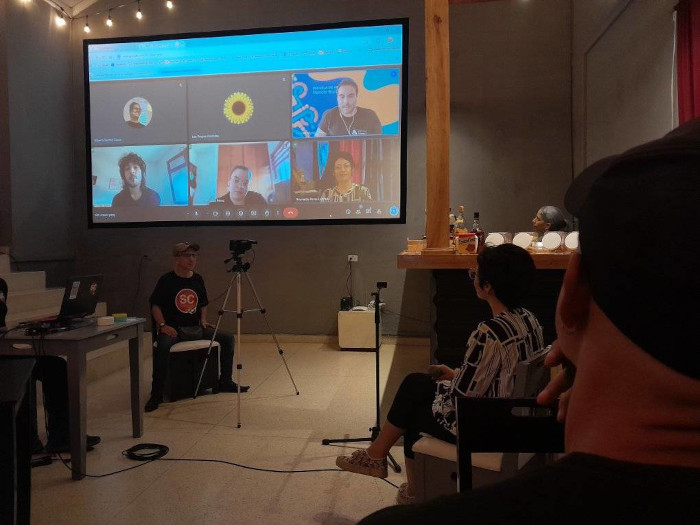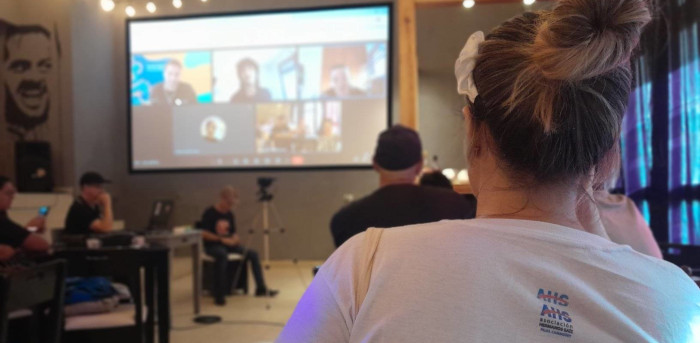CAMAGÜEY.- Almacén de la Imagen (Image Warehouse), faithful to its spirit of openness and connection between young creators, has extended its ties beyond the borders of Cuba, establishing an enriching link with film festivals in the Canary Islands, Spain. This relationship has been gaining strength and revealing common points between the new filmmakers of both regions. Now, it has taken a step further. From the Dodo's Café del Cine Encanto it motivated an online conversation with a professor and two students from the Manolo Blahnik Art School of La Palma.
There are five hours of difference between us, so while in Camagüey we were just beginning a cool morning, on the Isla Bonita they were already entering the sacred hour of the Spanish siesta. The dialogue allowed us to draw parallels and differences between our educational realities, reflecting on how, from different contexts, art continues to be a bridge to connect cultures and generations.
This meeting, designed for the participants of El Almacén de la Imagen, was especially interesting, since they are usually film students, although mostly at the university level. Professionals also attend, which brings diversity to the dialogue. Here in Cuba, art schools such as the Manolo Blahnik Art School are at the middle level, and although the study program mainly addresses traditional genres in the visual arts, audiovisual production has a limited presence. Complementary subjects that explore video creation and photography are rare, leaving these subjects to be developed more thoroughly at the university level.
In Camagüey, we have a branch of the University of the Arts of Havana, where Audiovisual Communication is studied with profiles such as Direction, Production, Photography, Editing and Sound. This contrasts with the situation in La Palma, where the Manolo Blahnik Art School trains young people from the earliest levels, preparing the ground to explore the creative potential of audiovisuals from an early age.

The Almacén de la Imagen is, therefore, a unique platform for participants, as it offers the opportunity to project their works on a big screen, in front of a real audience. This contact is invaluable, as many of their creations do not find space in the official exhibition circuit.
Based on these reflections, the exchange opened a door to explore the characteristics of the Manolo Blahnik Art School: who has access to it and at what age? What can be studied there according to the study plans? What is the process of creating student works like? Do students have technology from the school or do they depend on their own equipment? And, perhaps most importantly, what does the institution do to promote the work of its students, to connect them with key festivals such as Festivalito or initiatives such as the mapping of Medina del Campo?
Professor Damián Martín Brito, with his outstanding training in Audiovisual Communication and his career in the field of journalism, audiovisual production and teaching, provided a broad and professional vision of the audiovisual world. His experience as a teacher allowed him to articulate an inspiring speech, in which he combined technical and creative knowledge with a reflection on the transformative role of visual media. His intervention was particularly valuable to understand how artistic education can be a catalyst for the personal and professional development of young people.
For their part, students Sandra González Pérez and Vidal Ramos Negrín provided a sample of the emerging talent that is being trained at the Manolo Blahnik Art School.
In her presentation, Sandra highlighted the versatility and commitment to visual creation. Her experience in graphic design and photography, together with her participation in significant projects such as the mentor program of the Mapping Me! Festival, demonstrate the interest in linking art with the social and cultural environment of La Palma. Her perspective provided a practical approach on how young people can apply their knowledge to generate impact in their community.
Vidal, on the other hand, offered a deeply personal and artistic testimony. His video poems and short films not only demonstrate his technical mastery, but also his ability to express universal experiences and questions through audiovisual language. His raw and reflective stories, awarded at various festivals, served as a reminder of how art can become a tool to explore and share the complexity of the human experience.
After the conversation, attendees were able to enjoy the Dodo’s Café del Cine Encanto featured a collateral sample of seven Canarian student works. The ensemble made clear their commitment to cultural, existential and social themes, while experimenting with diverse narratives and techniques. The screening was a moment of connection and learning, which allowed Cuban attendees to appreciate both the thematic diversity and the talent of the young filmmakers of the “Manolo Blahnik”.
Among the outstanding works was La miel en los labios, a documentary directed by Aldo González that explores the tradition of palm syrup on the island of La Gomera. This work stands out for its ability to capture the cultural value of a rural trade, deeply rooted in the identity of its community.
Vidal Ramos Negrín screened Porque te quiero, an emotional fictional story that reflects on love based on the relationship observed between the director’s grandparents. This short film showed Vidal’s sensitivity in dealing with universal themes from an intimate and genuine perspective. His participation in several works in the program underlines the collaborative dynamic that characterizes the school.
Celia González presented two different but equally thoughtful pieces.
In Folie à deux, where she also acts and is in charge of the camera and other specialties, she explores human connections. On the other hand, together with Aldo, she co-directed SAI, an intriguing story about a school in which artificial intelligence replaces the teacher. Although speculative, the premise of this short is not so far from reality, as demonstrated by the case of a secondary school in Germany that is already experimenting with a humanoid robot teacher.
The short film Calcetines, directed by Tamara Rodríguez, addresses social inclusion and the problems of exclusion, especially in the school context. Like SAI, it places the narrative in the educational field, making students and schools become protagonists of stories that address social and human conflicts. This is a success, as it allows young viewers to identify with and reflect on their own realities.
Ánima was also screened, a work by Nieves Riera that uses the fragmented screen technique to evoke the connection between the island, the sea and the female figure, recurring elements in Canarian audiovisual production. Its visual proposal stands out for its symbolic charge and innovative aesthetics.
Finally, Doppelgänger, by Yenthamí Pérez, explored the disturbing concept of the ghostly double as a symbol of bad omen. This short fascinated with its suggestive atmosphere and its ability to develop a psychological narrative that keeps the viewer in suspense.
One aspect that unites emerging filmmakers from Cuba and La Palma is the constant challenge of the budget. Making films is still expensive everywhere: renting equipment, finding locations and managing production represent barriers that require creativity to overcome.
In the case of Canarian students, the Manolo Blahnik Art School plays a fundamental role by providing technical equipment that alleviates part of this burden. However, both in Cuba and in La Palma, the real driving force behind many works is the will and enthusiasm of friends.
Practicing empathy and friendship is key to carrying out projects that, although modest in resources, have a great impact on the connection between young people passionate about telling stories and the audience that receives them. These supportive networks demonstrate that cinema is an art and also a collective effort that celebrates the desire to communicate and transform.
Translated by Linet Acuña Quilez



